
So you need to switch to Jeppesen plates? There are a variety of reasons why you would need to switch. Whatever the reason, switching to different plates is a pain at first.
Don’t worry, though, the information is the same, it’s just located in different places.
I am not here to argue which is better. I have used both extensively for my job with an airline and for the military.
They both have their ups and downs.
This article will cover the differences in Approach Plates.
I have already discussed the differences in Airport Diagrams in Part 1 and I will cover the Standard Instrument Departures in Part 3.
APPROACH PLATES
Let’s start with some examples. Take a second to digest the different plates.
The first is the Jeppesen plate for the ILS into KPDX. The second is the FAA’s version.
The blue dot on the FAA plate shows where I live in case anyone is wondering. I have the more expensive version of Foreflight which ties into the GPS. It’s worth the money.
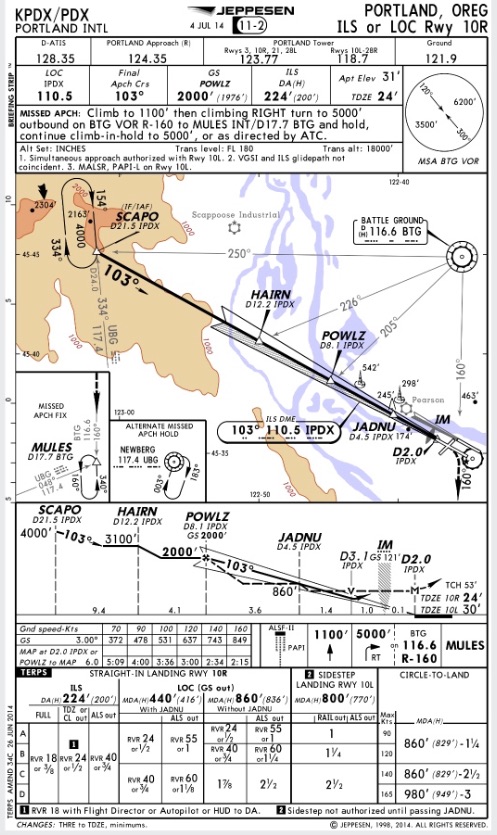
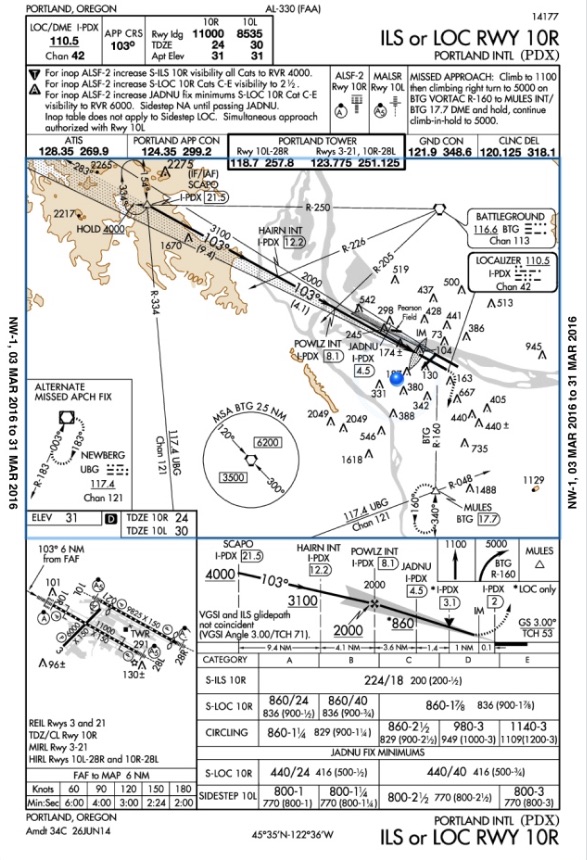
Difference #1: Chart numbers
You will notice the chart numbers are different. Each organization uses its own labeling system.
You can’t move back and forth between them. A “14177” FAA chart below means nothing in the Jeppesen world.
It’s important to be able to locate the chart numbers and expiration dates. You need to know if it’s the latest plate and you are on the same plate as your co-pilot when you brief the approach.
Check out the differences:


I just want to point out something that may confuse new Jeppesen chart users.
You need to understand the FAA does all the grunt work when it comes to “terping” or creating/validating approaches in the National Airspace system. It’s a major function of the FAA.
Jeppesen uses the information from the FAA to create it’s own charts.
So, while the Jeppesen plate may have a date of “4 JUL 14” on the top of the plate, it will still have an official “TERPS AMEND” date it gets from the FAA.
You can find that official date on the bottom left hand corner of the plate as I have shown below.
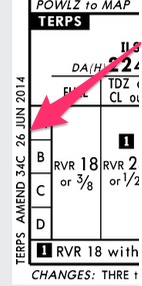
The FAA on the other hand only uses one date on the plate: the official “TERPS AMEND” date.

The “TERPS AMEND” dates will let you know if you have the most updated chart compared to your co-pilot.
Comparing the latest chart number is easier than comparing the dates, though. Whoever has the larger number (14177 vs 14176) has the latest plate on the FAA charts.
Difference #2: “Briefing Strip”
I just learned the term “briefing strip” is actually a trademark of Jeppesen plates. Look:
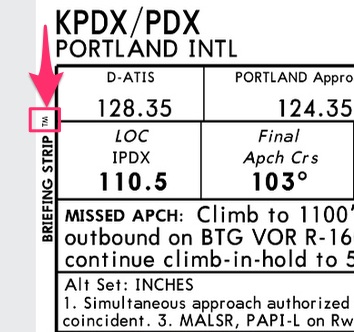
I had no idea. I have been using that term for a while, but I didn’t know where it came from.
There is a good reason Jeppesen plates trademarked the “briefing strip.” The primary difference between FAA and Jeppesen approach plates is the “Briefing Strip.”
Jeppesen wants all the information you need to brief an approach at the top of the chart. It makes life a lot easier for aircrews.
Jeppesen plates are usually used in cockpits with two pilots so this makes a lot of sense. Plus, they are a business, they need to give their customers a reason to drop all that money on their plates!
You could ignore the rest of the plate and still get everything you need from the briefing strip. You can get the same information from the FAA chart, you just have to jump around.
Here are the two “briefing strips” side by side, starting with the Jeppesen plate:
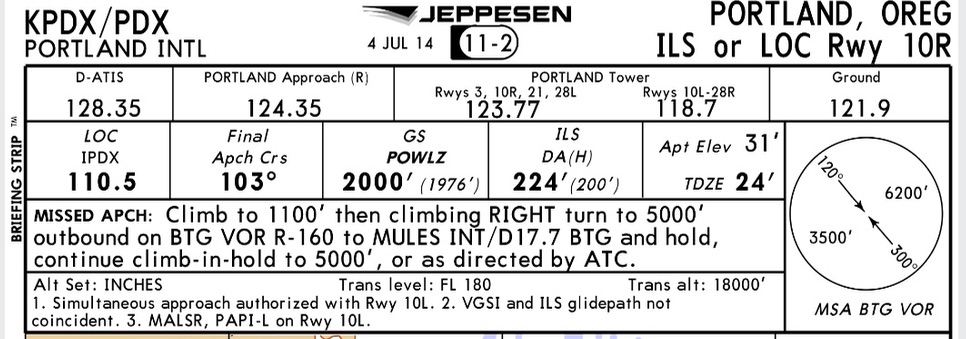

As you can see, the Jeppesen plate streamlines the information. It puts the information you see above in the FAA plate in other areas.
Difference #3: Plan View
I have found Jeppesen’s goal is to simplify and condense. The plan view is no exception.
As you can see the Jeppesen graphic portion is cleaner (except for all the arrows I drew to highlight differences):
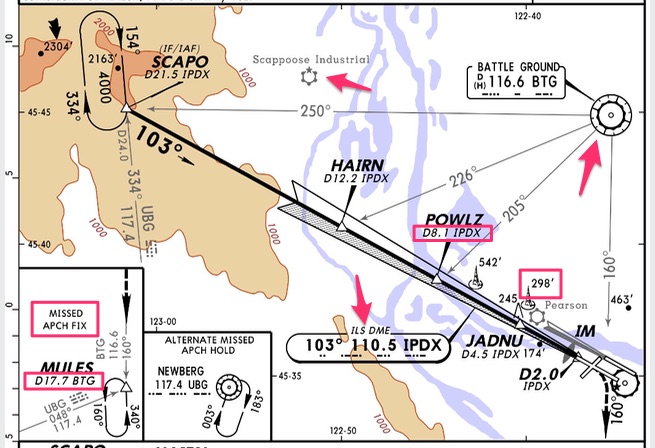
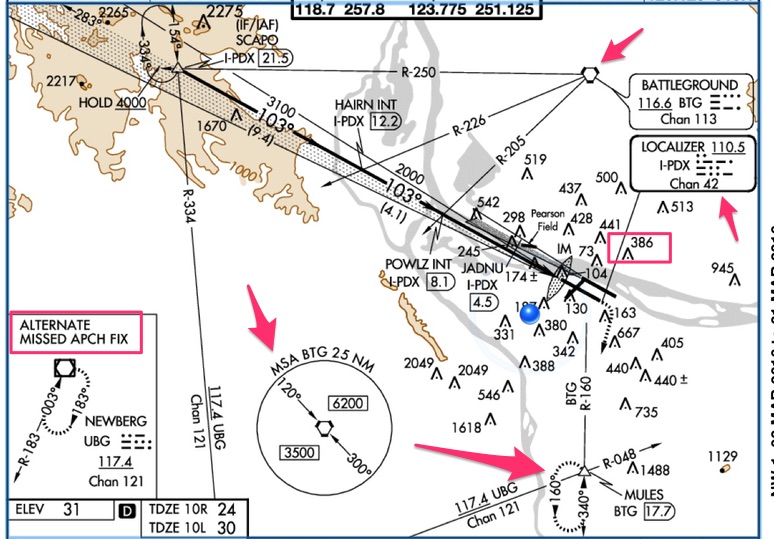
I used the pink arrows point out a few of the differences.
Below is a written list of the differences:
- The Jepp plates use different icons for their VORs and ILSes. The FAA charts use similar boxes, so you need to pay close attention to distinguish between the Localizer frequency or the VOR.
- The FAA charts use little boxes around their distances from VORs.
- Look at the FAA chart which shows MULES 17.7 NM from the BTG VOR. Notice the Jepp charts don’t outline/circle any distances. They use the word “D” before the distance instead.
- The “D” is consistent across all Jepp charts to denote distances.
- The FAA charts put the MSA chart in the plan view which is very helpful in my opinion.
- This is the altitude you cannot descend below if you are cut lose by ATC to do the approach. You may hit a mountain (and people have) if you descend too early. The Jepp plates put it in the briefing strip because they think it’s important to brief.
- Notice the FAA charts put almost every damn antenna in Portland in the plan view. The Jeppesen plates are a little more discerning with their antenna heights. It’s cleaner.
- The FAA plate does not include local airports. I drew an arrow to the Scappoose airport symbol on the Jeppesen plate to show you what an airport on a Jeppesen plate looks like.
- The Jeppesen plates puts the missed approach and alternate in their own boxes. The FAA charts like to put the missed approach in the plan view to show you holding in relation to the airport. The FAA will put the alternate in a box when applicable.
Difference #4: Side View
The side views are very different mainly because the FAA charts throw a miniature airport diagram into the bottom of their approach plates and the Jeppesen plates leave out that detail.
Look:
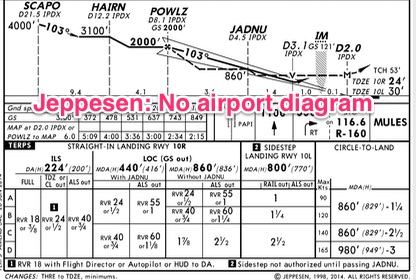
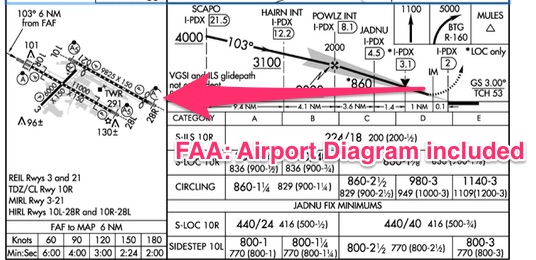
Omitting the diagram frees up more room in the Jepp plates for a stretched side view.
Check out the side view starting with the Jeppesen plate:


Sometimes in an attempt to clean up the plate, the Jeppesen plates leave out information you have to find elsewhere.
For example, look at the star (*) next to the 860 feet. I drew and arrow to it.
Notice on the FAA chart it tells you it’s for the Localizer only. On the Jeppesen plate you have to go to the section with DH/MDA to interpolate that information.
The Jeppesen plate also omits the line under the altitudes. In this case, you would have to know that 4000′ is a hard altitude on the Jeppesen plate.
The FAA plate underlines 4000′ (I drew an arrow to it) so you can quickly identify mandatory altitudes.
The FAA adds two things you won’t find on the side view in a Jepp plate:
- The graphical depiction of the missed approach
- A note about “VGSI and ILS glidepath not coincident.” You have to go back to the top of the plate and put on your glasses to find that information on the Jeppesen plate:

TEACHING TANGENT: If you have ever flown an approach where the glidepath and Visual Glideslope Indicator (VGSI) aren’t coincident, you know how annoying it is to find yourself perfectly on glidepath on your instruments, but off when you look at the PAPI.
This also happens when approach angles are greater than 3 degrees.
I recommend when you break out, transition to flying the PAPI (or other VGSI) with only an occasional glance at your glidepath.
The glidepath on your instruments is still helpful, but you will drive yourself crazy trying to stay on the glidepath when the PAPI tells you a different story.
Any distraction while trying to land is a bad thing, and jockeying with the glidepath vs the PAPI is a distraction.
You won’t notice this problem when you break out close to minimums because you might not see the PAPI before you flare and land.
Difference #5: MDH/DH and Circling Minimums
The main difference here is how the information is arranged.
The Jeppesen plates follow a vertical format and the FAA charts arrange the information horizontally.
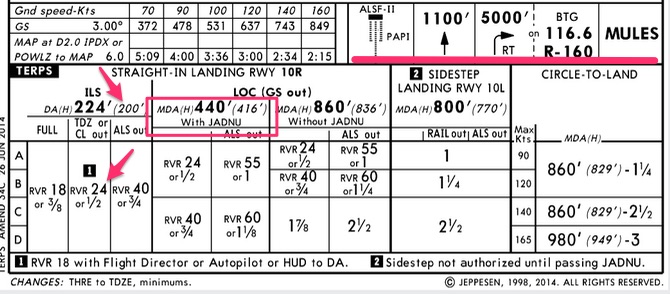
The Jeppesen plates also add the visual depiction of the missed approach procedure and the descent rates to the top portion.
Another nice feature of the Jeppesen plates is they do the math for you if any of the lighting systems are out.
In the FAA charts, you have to go back up to the “briefing strip” section and look at the notes to find out what your new MDA/DH numbers are.
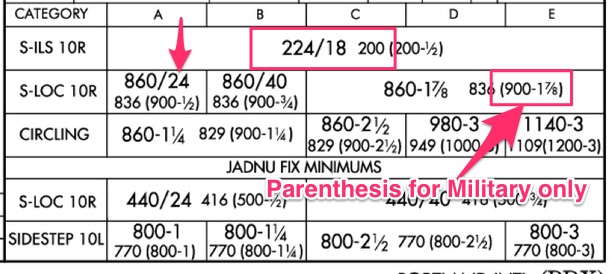
In the Jeppesen plates you will notice the Height Above Touchdown (HAT) is in parenthesis whereas the FAA charts place the HAT to the right of the DH and visibility for the approach.
For example, on the ILS the DH is 220 feet and the required RVR is 1800. Just to the right of those numbers you will see the “200” which means when you are at minimums you are 200 feet above the ground.
TEACHING TANGENT: The HAT useful to know. If the ceilings are 600′ and the HAT is 200′ you will have 400′ between you and the clouds when you break out.
You should do this math right after getting ATIS and before descent so you know when you will break out.
Difference #6: No military information on Jeppesen plates
Take a look at the FAA charts and notice how it adds additional information in parenthesis to the right of the HAT.
These numbers are for military pilots only. It helps them determine if they need an alternate.
The Jeppesen plates do not have information for military pilots on their plates. You are out of luck.
Usually military pilots flying overseas will use the DOD approved plates which mirror the FAA charts, so they have access to this important planning information.
For example, the ILS shows (200-1/2) for weather planning minima. As an Army fixed-wing pilot I add 400′ and 1 mile visibility to that number to get 600 and 1 and 1/2. If the weather is less than 600 1 and 1/2 within an hour of landing, I must plan for a landing alternate.
Likewise, if the weather is less than 200 1/2 when I takeoff, I must plan for a takeoff alternate.
TEACHING TANGENT: Civilian pilots (operating under Part 121 and 135) using Jeppesen plates must refer to the Airport Diagram for takeoff and landing minimums. See Part 1 of this article for where to find that info.
Part 91 civilian pilots have no takeoff minimums or takeoff alternate requirements, although you are a fool if you don’t give yourself some personal minimums.
For four different recommendations on suggested personal minimums check out this article: What are standard takeoff minimums?
I also recommend you plan for a takeoff alternate when the weather is below the MDA/DH for the approach.
If you have an emergency on takeoff and the weather is less than the MDA/DH, how will you get back into the airport you just left? You will need another airport, and trying to chose one in the air during an emergency is foolish.
Part 91 pilots can also initiate approaches when the visibility is less than required for the approach (ie 1/2 mile visibility or 1800 RVR).
Part 121 and 135 pilots have to have certain RVR requirements before they can even attempt an approach.
The military mirrors Part 91 in that they can initiate any approach regardless of weather.
However, no matter who you are, in order to descend below MDA/DH you have to make sure “the visibility is not less than the visibility prescribed in the standard instrument approach being used.”
If the visibility for the ILS is 1/2 mile then you must have 1/2 mile visibility to go below the MDA/DH.
The visibility, not ceiling is controlling.
Additionally, you can’t go below 100′ AGL until you see some of the approach or runway lights. There is a whole long laundry list I won’t go into. They are listed in CFR Part 91.175. You can click on that link to read the pdf.
Whew! That’s it.
I didn’t cover all of the differences in the charts. I will let you look at the different pictures and pick out the more minute changes. This article should get you most of the way.
Thanks for bearing with me and letting me go on some teaching tangents. I add those in because I had these same questions when trying to find this information and no one answered them clearly.
I figured someone else probably has the same questions especially if you are in the military trying to switch over to the airlines.
If I made any mistakes, or didn’t answer something clearly, let me know by emailing me at: sarah@thinkaviation.net
Do you want weekly tips and resources?
Subscribe to keep learning.